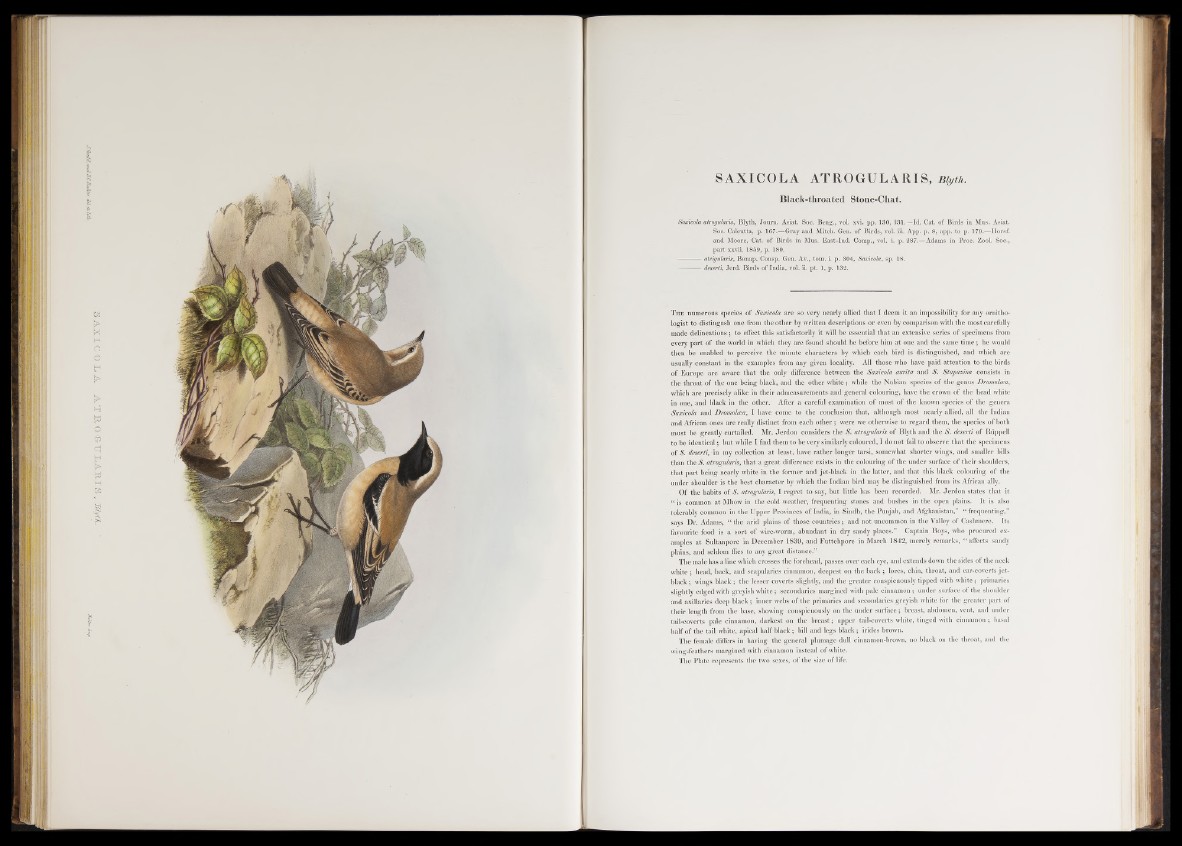
SAXICOLA ATROGULARIS, Blyth.
Black-throated Stone-Chat.
Saxicola atrogularis, Blyth, Joum. Asiat. Soc. Beng., vol. xvi. pp. 130, 131.—Id. Cat. of Birds in Mus. Asiat.
Soc. Calcutta, p. 167.—Gray and Mitch. Gen. of Birds, vol. iii. App. p. 8, app. to p. 179.—Horsf.
and Moore, Cat. of Birds in Mus. East-Ind. Comp., vol. fe-pj 287.—Adams in Proc. Zool. Soc.,
part xxvii. 1859, p. 180.
— atrigularis, Bonap. Consp. Gen. Av., tom. i. p. 304, Saxicola, sp. 18.
— deserti, Jerd. Birds of India, vol. ii. pt. 1, p. 13‘2.
T h e numerous species of Saxicola are so very nearly allied that I deem it an impossibility for any ornithologist
to distingush one from the other by written descriptions or even by comparison with the most carefully
made delineations; to effect this satisfactorily it will be essential that an extensive series of specimens from
every part o f the world in which they are found should be before him a t one and the same tim e ; he would
then be enabled to perceive the minute characters by which each bird is distinguished, and which are
usually constant in the examples from any given locality. All those who have paid attention to the birds
of Europe are aware th at the only difference between the Saxicola aurita and S. Stapazina consists in
the throat of the one being black, and the other white 5 while the Nubian species of the genus Dromolcea,
which are precisely alike in their admeasurements and general colouring, have the crown of the head white
in one, and black in the other. After a careful examination of most of the known species of the genera
Saxicola and Dromolcea, I have come to the conclusion that, although most nearly allied, all the Indian
and African ones are really distinct from each o th e r ; were we otherwise to regard them, the species of both
must be greatly curtailed. Mr. Jerdon considers the S. atrogularis of Blyth and the S. deserti of Riippell
to be identical; but while I find them to be very similarly coloured, I do not fail to observe that the specimens
of S . deserti, in my collection a t least, have rather longer tarsi, somewhat shorter wings, and smaller bills
than the S. atrogularis, that a great difference exists in the colouring o f the under surface o f their shoulders,
that p a rt being nearly white in the former and jet-black in the latter, and that this black colouring of the
under shoulder is the best character by which the Indian bird may be distinguished from its African ally.
Of the habits of S . atrogularis, I regret to say, but little has been recorded. Mr. Jerdon states that it
“ is common a t Mhow in the cold weather, frequenting stones and bushes in the open plains. It is also
tolerably common in the Upper Provinces o f India, in Sindh, the Punjab, and Afghanistan,” “ frequenting,”
says Dr. Adams, “ the arid plains of those countries; and not uncommon in the Valley o f Cashmere. Its
favourite food is a sort of wire-worm, abundant in dry sandy places.” Captain Boys, who procured examples
a t Sultanpore in December 1839, and Futtehpore in March 1842, merely remarks, “ affects sandy
plains, and seldom flies to any great distance/’
The male has aline which crosses the forehead, passes over each eye, and extends down the sides of the neck
white ; head, back, and scapularies cinnamon, deepest on the b a ck ; lores, chin, throat, and ear-coverts jet-
black ; wings black; the lesser coverts slightly, and the greater conspicuously tipped with white; primaries
slightly edged with greyish w hite; secondaries margined with pale cinnamon; under surface of the shoulder
and axillaries deep black; inner webs of the primaries and secondaries greyish white for the greater part of
their length from the base, showing conspicuously on the under surface; breast, abdomen, vent, and under
tail-coverts pale cinnamon, darkest on the b reast; upper tail-coverts white, tinged with cinnamon ; basal
half of the tail white, apical half black; bill and legs black; irides brown.
The female differs in having the general plumage dull cinnamon-brown, no black on the throat, and the
wing-feathers margined with cinnamon instead of white.
The Plate represents the two sexes, of the size of life.